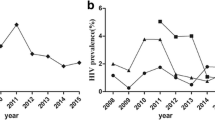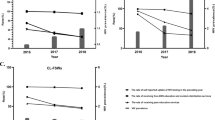Abstract
We estimated the prevalence of recent HIV testing (i.e., having an HIV test during the last 12 months and knew the results) among 1295 HIV-negative Iranian female sex workers (FSW) in 2015. Overall, 70.4% (95% confidence intervals: 59.6, 79.3) of the participants reported a recent HIV testing. Concerns about their HIV status (83.2%) was reported as the most common reason for HIV testing. Incarceration history, having >5 paying partners, having >1 non-paying partner, receiving harm reduction services, utilizing healthcare services, and knowing an HIV testing site were significantly associated with recent HIV testing. In contrast, outreach participants, having one non-paying sexual partner, and self-reported inconsistent condom use reduced the likelihood of recent HIV testing. HIV testing uptake showed a ~2.5 times increase among FSW since 2010. While these findings are promising and show improvement over a short period, HIV testing programs should be expanded particularly through mobile and outreach efforts.



Similar content being viewed by others
References
Joint United Nations Programme on HIV/AIDS (UNAIDS). Global AIDS Update 2016 http://www.unaids.org/sites/default/files/media_asset/global-AIDS-update-2016_en.pdf (2016). Accessed 16 Oct 2016.
Gokengin D, Doroudi F, Tohme J, Collins B, Madani N. HIV/AIDS: trends in the Middle East and North Africa region. Int J Infect Dis. 2016;44:66–73.
Joint United Nations Programme on HIV/AIDS (UNAIDS). The gap report 2014. http://www.unaids.org/sites/default/files/media_asset/UNAIDS_Gap_report_en.pdf (2014). Accessed 8 Aug 2015.
UNAIDS. Prevention Gap Report 2016. http://www.unaids.org/sites/default/files/media_asset/2016-prevention-gap-report_en.pdf (2016). Accessed 15 Feb 2017.
Baral S, Beyrer C, Muessig K, Poteat T, Wirtz AL, Decker MR, et al. Burden of HIV among female sex workers in low-income and middle-income countries: a systematic review and meta-analysis. Lancet Infect Dis. 2012;12:538–49.
Platt L, Jolley E, Rhodes T, Hope V, Latypov A, Reynolds L, et al. Factors mediating HIV risk among female sex workers in Europe: a systematic review and ecological analysis. BMJ Open. 2013;3:e002836.
Shannon K, Strathdee SA, Goldenberg SM, Duff P, Mwangi P, Rusakova M, et al. Global epidemiology of HIV among female sex workers: influence of structural determinants. Lancet. 2015;385:55–71.
Paz-Bailey G, Noble M, Salo K, Tregear SJ. Prevalence of HIV among U.S. female sex workers: systematic review and meta-analysis. AIDS Behav. 2016;20:2318–31.
Iran AIDS Progress Report. Islamic Republic of Iran AIDS Progress Report: On monitoring of the United Nations General Assembly Special Session on HIV and AIDS; March 2015. National AIDS Committee Secretariat, Ministry of Health and Medical Education. http://www.unaids.org/sites/default/files/country/documents/IRN_narrative_report_2015.pdf (2015). Accessed 15 Oct 2016.
Shokoohi M, Karamouzian M, Osooli M, Sharifi H, Fahimfar N, Haghdoost A, et al. Low HIV testing rate and its correlates among men who inject drugs in Iran. Int J Drug Policy. 2016;32:64–9.
Shokoohi M, Karamouzian M, Khajekazemi R, Osooli M, Sharifi H, Haghdoost AA, et al. Correlates of HIV testing among female sex workers in Iran: findings of a national bio-behavioural surveillance survey. PLoS ONE. 2016;11:e0147587.
World Health Organization (WHO). Prevention and treatment of HIV and other sexually transmitted infections for sex workers in low- and middle-income countries: recommendations for a public health approach. Geneva: World Health Organization. http://apps.who.int/iris/bitstream/10665/77745/1/9789241504744_eng.pdf?ua=1 (2012). Accessed 15 Oct 2016.
Baggaley R, Dalal S, Johnson C, Macdonald V, Mameletzis I, Rodolph M, et al. Beyond the 90-90-90: refocusing HIV prevention as part of the global HIV response. J Int AIDS Soc. 2016;19(1):21348.
Fahimfar N, Sedaghat A, Hatami H, Kamali K, Gooya M. Counseling and harm reduction centers for vulnerable women to HIV/AIDS in Iran. Iran J Public Health. 2013;42:98–104.
World Health Organization (WHO). Guidance on provider-initiated HIV testing and counselling in health facilities. Geneva: World Health Organization. http://www.who.int/hiv/topics/vct/PITCguidelines.pdf (2007). Accessed 15 Oct 2016.
Sajadi L, Mirzazadeh A, Navadeh S, Osooli M, Khajehkazemi R, Gouya MM, et al. HIV prevalence and related risk behaviours among female sex workers in Iran: results of the national biobehavioural survey, 2010. Sex Transm Infect. 2013;89(Suppl 3):iii37–40.
UNGASS. United Nations General Assembly Special Session on HIV/AIDS. Monitoring the declaration of commitment on HIV/AIDS guidelines on construction of core indicators. http://www.unaids.org/sites/default/files/sub_landing/files/jc1676_core_indicators_2009_en.pdf (2010). Accessed 16 Oct 2016.
Rao JNK, Scott AJ. The analysis of categorical data from complex sample surveys: Chi squared tests for goodness of fit and independence in two-way tables. J Am Stat Assoc. 1981;76:221–30.
Zou G. A modified poisson regression approach to prospective studies with binary data. Am J Epidemiol. 2004;159:702–6.
Vittinghoff E, Glidden DV, Shiboski SC, McCulloch CE. Regression methods in biostatistics: linear, logistic, survival, and repeated measures models: in chapter 12: complex survey. 2nd ed. New York: Springer; 2012. p. 474.
Maldonado G, Greenland S. Simulation study of confounder-selection strategies. Am J Epidemiol. 1993;138:923–36.
van Buuren S. Multiple imputation of discrete and continuous data by fully conditional specification. Stat Methods Med Res. 2007;16:219–42.
Rubin DB. Multiple imputation for nonresponse in surveys. New York: Wiley; 1987.
Sharifi H, Karamouzian M, Baneshi MR, Shokoohi M, Haghdoost AA, McFarland W, et al. Population size estimation of female sex workers in Iranian cities: synthesis of methods and results. PLoS One. 2017 (under review).
Iran AIDS Progress Report. Islamic Republic of Iran AIDS progress report: on monitoring of the united nations general assembly special session on HIV and AIDS. National AIDS Committee Secretariat, Ministry of Health and Medical Education. http://files.unaids.org/en/dataanalysis/knowyourresponse/countryprogressreports/2014countries/IRN_narrative_report_2014_en.pdf (2014). Accessed 15 Oct 2016.
Pant Pai N, Sharma J, Shivkumar S, Pillay S, Vadnais C, Joseph L, et al. Supervised and unsupervised self-testing for HIV in high- and low-risk populations: a systematic review. PLoS Med. 2013;10:e1001414.
World Health Organization. WHO issues new guidance on HIV self-testing ahead of World AIDS Day 29 Nov 2016. Geneva: WHO; 2017.
Mirzazadeh A, Shokoohi M, Haghdoost AA, et al. The Iran Vulnerable Women’s Study 2015, regional knowledge Hub, and WHO Collaborating Centre for HIV surveillance, Tehran [unpublished report]; 2015.
PEPFAR. Using programmatic mapping to improve program access and coverage for key populations—guidelines for countries. Washington, DC: PEPFAR; 2015.
Gwadz M, Cleland CM, Jenness SM, Silverman E, Hagan H, Ritchie AS, et al. Exploring factors associated with recent HIV testing among heterosexuals at high risk for HIV infection recruited with venue-based sampling. J AIDS Clin Res. 2016;7:544.
Tsereteli N, Chikovani I, Chkhaidze N, Goguadze K, Shengelia N, Rukhadze N. HIV testing uptake among female sex workers and men who have sex with men in Tbilisi, Georgia. HIV Med. 2013;14(Suppl 3):29–32.
Rhodes SD, Vissman AT, Stowers J, Miller C, McCoy TP, Hergenrather KC, et al. A CBPR partnership increases HIV testing among men who have sex with men (MSM): outcome findings from a pilot test of the CyBER/testing internet intervention. Health Educ Behav. 2011;38:311–20.
Wilson D. HIV programs for sex workers: lessons and challenges for developing and delivering programs. PLoS Med. 2015;12:e1001808.
Jenness SM, Murrill CS, Liu KL, Wendel T, Begier E, Hagan H. Missed opportunities for HIV testing among high-risk heterosexuals. Sex Transm Dis. 2009;36:704–10.
Acknowledgements
The authors would like to acknowledge the study participants whom provided important information to public health practice and research. We gratefully acknowledge the dedication of all the provincial supervisors, facilities’ staff and outreach team, and support team efforts of Maryam Esmaili, Leila Mostafavi and Azam Valipour.
Funding
This study and the authors were supported by the Global Fund to Fight AIDS, Tuberculosis and Malaria. Additional support was received from CDC-Iran, University of California, San Francisco’s International Traineeships in AIDS Prevention Studies (ITAPS), U.S. NIMH, R25 MH064712 (Ali Mirzazadeh).
Author information
Authors and Affiliations
Corresponding author
Rights and permissions
About this article
Cite this article
Shokoohi, M., Noori, A., Karamouzian, M. et al. Remaining Gap in HIV Testing Uptake Among Female Sex Workers in Iran. AIDS Behav 21, 2401–2411 (2017). https://doi.org/10.1007/s10461-017-1844-0
Published:
Issue Date:
DOI: https://doi.org/10.1007/s10461-017-1844-0




